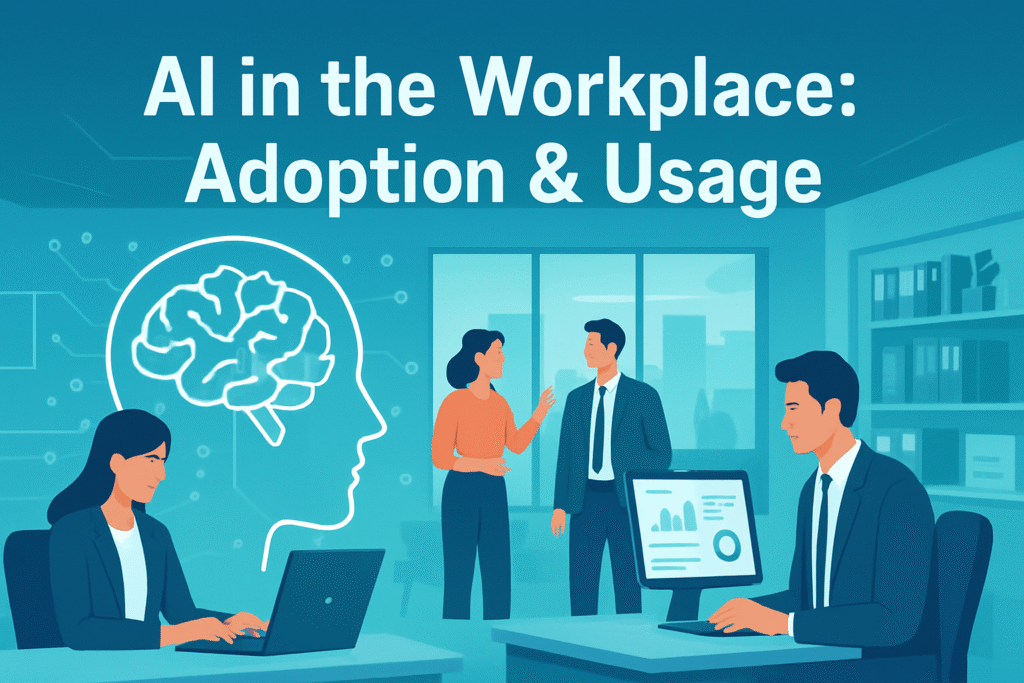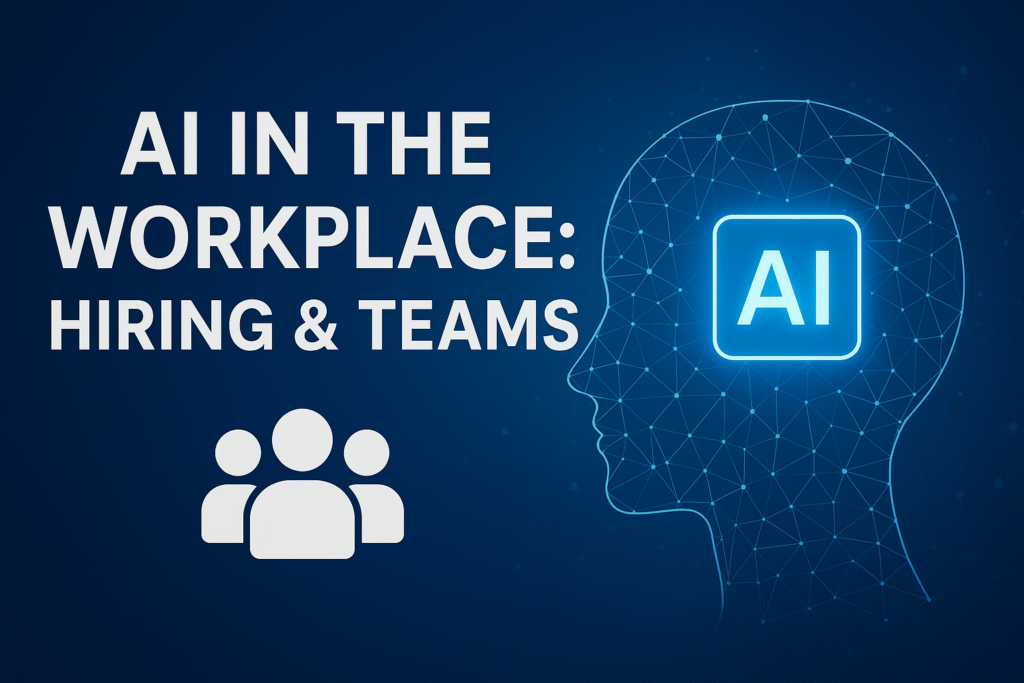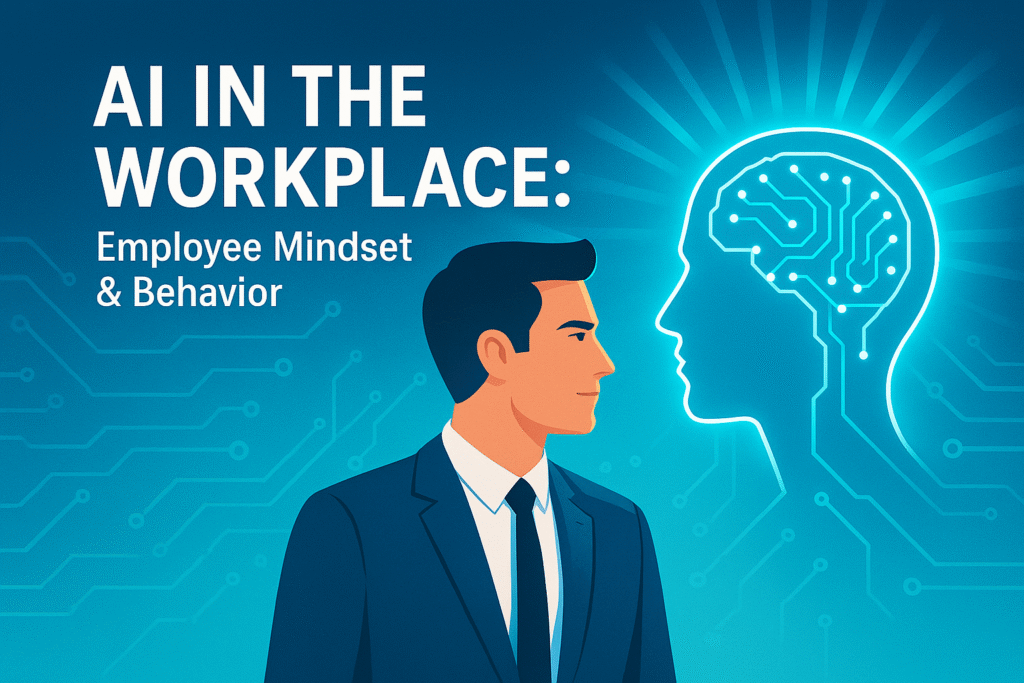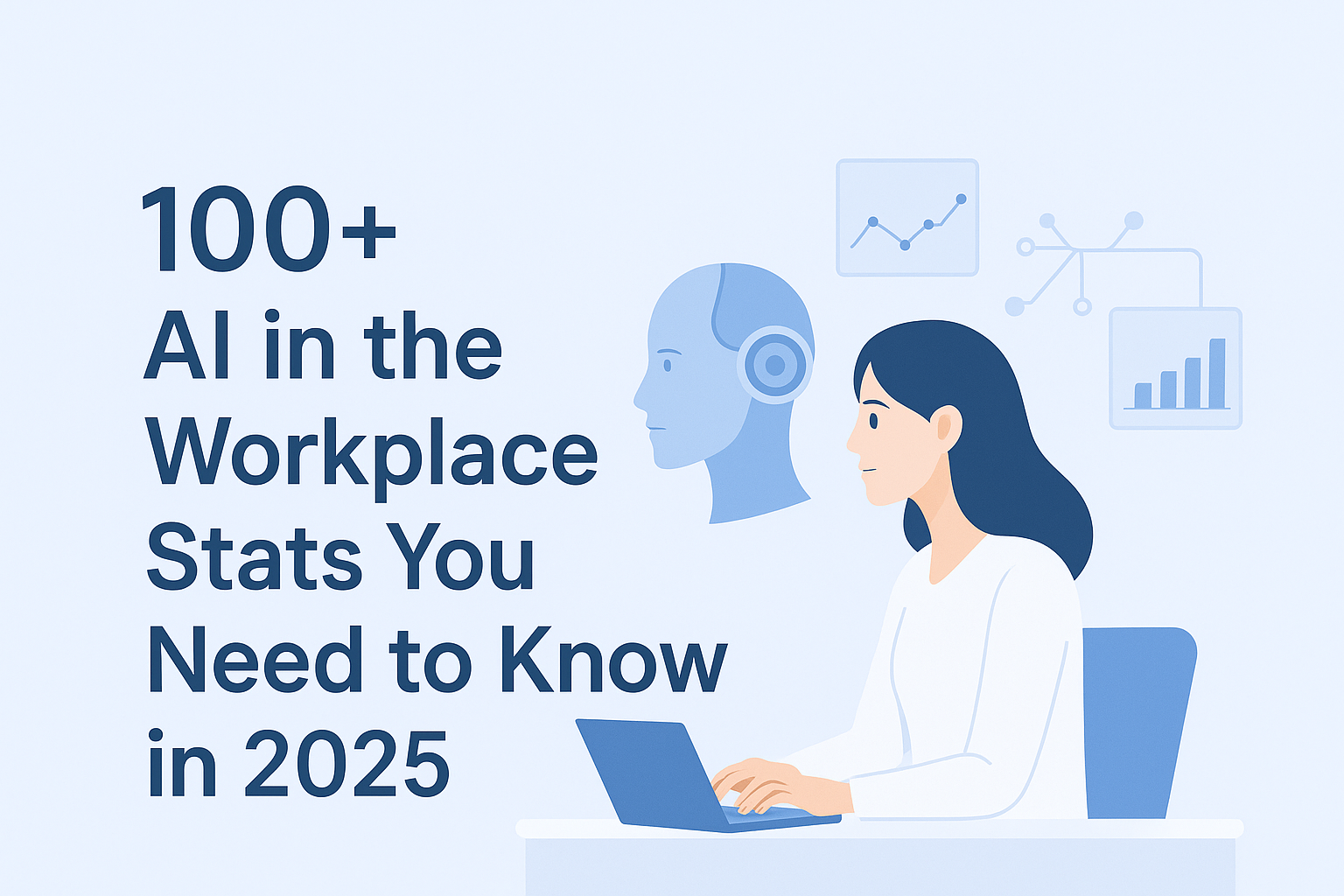Discover 100+ AI in the workplace stats for 2025, from adoption and productivity to hiring, skills, and leadership insights. Stay ahead of workplace trends shaping the AI-powered future. Subscribe to our LinkedIn Newsletter for regular updates.
TL;DR (10 Headline Stats)
Here are the must-know numbers from the 2025 workplace AI landscape:
- 78% of organisations now use AI in at least one business function (Stanford HAI).
- 71% report generative AI adoption across at least one function (Stanford HAI).
- 17% of organisations attribute ≥5% of earnings before interest and taxes (EBIT) to generative AI (Stanford HAI).
- 29% of leaders save at least one hour per day using AI (Stanford HAI).
- 47% of organisations have already experienced at least one negative generative AI consequence (Stanford HAI).
- 83% of leaders believe AI will enable employees to take on more complex work earlier (Work Trend Index).
- 91% of learning and development professionals say human skills are more important than ever in 2025 (LinkedIn).
- 69% of technology leaders expect generative AI to expand, not shrink, hiring on their teams (Deloitte).
- By 2030, 70% of skills used in today’s jobs will change due to AI (LinkedIn).
- Generative AI–exposed industries saw 27% revenue per employee growth, compared with 8.5% for the least exposed (PwC).
AI is no longer an experiment; it’s the backbone of modern work.
2025 is the pivot year when AI moves from experimentation to transformation, reshaping workflows, skill demands, and workforce design. Here are the most important AI in the workplace statistics for 2025, with quick takeaways you can act on.
Table of Contents
Adoption & Usage

AI adoption has shifted from pilots to widespread daily use, with both leaders and employees weaving it into core workflows.
- 78% of organisations report using AI in at least one business function (2024 baseline) (Stanford HAI)
Takeaway: AI has become a standard feature of enterprise operations. - 71% report generative AI adoption in at least one function (Stanford HAI)
Takeaway: Gen-AI is quickly following in the footsteps of broader AI adoption. - The average organisation now uses AI across three functions, up from two in 2022 (Stanford HAI)
Takeaway: Companies are scaling AI usage horizontally across departments. - IT saw the biggest one-year usage jump (27% → 36%) (Stanford HAI)
Takeaway: Technical functions are leading adoption, paving the way for others. - 53% of surveyed executives say they personally use generative AI tools regularly (Stanford HAI)
Takeaway: Executive-level adoption signals top-down cultural change. - 21% of organisations have redesigned key workflows to capture generative AI value (Stanford HAI)
Takeaway: True transformation comes when processes, not just tools, change. - 78% of leaders say they trust AI for high-stakes work vs 66% of employees (Microsoft Work Trend Index)
Takeaway: Leaders show more confidence than employees in AI reliability. - 69% of leaders use AI several times a week vs 45% of employees (Microsoft WTI)
Takeaway: A usage gap exists between decision-makers and frontline staff. - 67% of leaders are at least “familiar” with AI agents vs 40% of employees (Microsoft WTI)
Takeaway: Awareness of AI agents is concentrated at the leadership level. - 52% of employees see AI as a command tool; 46% as a thought partner (Microsoft WTI)
Takeaway: Worker perceptions of AI are split between tool and collaborator. - Employees use AI most for 24/7 availability (42%) and speed/quality (30%) (Microsoft WTI)
Takeaway: Reliability and efficiency are the top drivers of workplace use. - 28% cite “endless ideas” as a reason to use AI over colleagues (Microsoft WTI)
Takeaway: Creativity on demand is a unique advantage workers see in AI. - 23% cite “limitless capacity” as a reason to use AI over colleagues (Microsoft WTI)
Takeaway: Scalability makes AI an attractive supplement to human work. - 8–17% cite avoiding negative dynamics (e.g., credit-hogging, judgment) as a reason to use AI (Microsoft WTI)
Takeaway: Some employees prefer AI because it avoids interpersonal friction. - 29% of leaders already save ≥1 hour per day using AI (Microsoft WTI)
Takeaway: Productivity gains for leaders are measurable and growing.
Investment, Value & Economics
AI isn’t just transforming workflows; it’s reshaping corporate value creation and the global investment landscape.
- 17% of organisations report ≥5% Earnings Before Interest and Taxes (EBIT) attributable to generative Artificial Intelligence so far (Stanford HAI).
Takeaway: Generative AI is already delivering measurable bottom-line impact for a meaningful share of companies. - Sectors most exposed to AI saw ~3× faster revenue per employee growth (27% vs 8.5%) (PwC Jobs Barometer)
Takeaway: AI-heavy industries are scaling productivity and efficiency much faster than their peers. - Global private AI investment rebounded sharply in 2024 after a 2023 dip (Stanford HAI)
Takeaway: Despite short-term fluctuations, investor confidence in AI’s long-term value remains strong. - The cost of Large Language Model (LLM) inference fell ~280× between Jan 2023 and Dec 2024 at similar quality levels (Stanford HAI)
Takeaway: Plummeting costs make advanced AI more affordable and scalable across industries. - 90%+ of frontier model advances now come from industry, not academia (Stanford HAI)
Takeaway: Corporate labs are driving the cutting edge of AI, shifting innovation power away from universities.
Process Redesign & AI Agents
AI is no longer just a tool; it’s becoming a co-worker. Leaders are rethinking workforce structures, processes, and even job roles around AI agents.
- 47% of leaders list “AI-specific upskilling” as a top 12–18 month strategy (Microsoft Work Trend Index)
Takeaway: Companies recognise that skills are the foundation of AI transformation. - 45% plan to hold headcount steady while using AI as digital labour (Microsoft WTI)
Takeaway: Many organisations see AI as augmentation, not replacement. - 33% are considering reducing headcount via AI; 32% plan reductions but with higher rewards for top performers (Microsoft WTI)
Takeaway: Workforce restructuring is coming, with winners and losers. - 32% plan to increase headcount alongside AI adoption (Microsoft WTI)
Takeaway: For some firms, AI creates enough demand to grow teams, not shrink them. - 28% of managers are considering hiring “AI workforce managers” (Microsoft WTI)
Takeaway: Overseeing AI-human collaboration is emerging as a real role. - 32% of leaders plan to hire “AI agent specialists” within 12–18 months (Microsoft WTI)
Takeaway: Managing and optimising AI agents is becoming a career path. - Within five years, leaders expect to: redesign processes with AI (38%), build multi-agent systems (42%), train agents (41%), and manage agents (36%) (Microsoft WTI)
Takeaway: The future workplace is being re-architected around AI agents and their ecosystems. - Deloitte predicts 25% of generative AI enterprises will deploy AI agents in 2025 (Deloitte)
Takeaway: AI agents are moving from concept to mainstream enterprise deployment.
Governance, Risk & Safety
As AI adoption accelerates, governance and risk management are becoming urgent priorities, yet many organisations remain underprepared.
- 47% of organisations experienced at least one negative generative AI consequence already (Stanford HAI)
Takeaway: Nearly half of companies have faced AI-related risks firsthand. - Only 27% require human review of all generative AI outputs today (Stanford HAI)
Takeaway: The majority of organisations lack full safety checkpoints. - 73% therefore, allow some AI output to ship without universal human checks (Stanford HAI)
Takeaway: Most companies are exposed to errors, bias, or compliance risks. - Governments issued record numbers of AI-relevant regulations in 2024 (Stanford HAI)
Takeaway: The regulatory environment is catching up fast, adding external pressure for compliance.
Leadership Sentiment & Organisational Design
2025 marks a turning point in how organisations are structured around AI, with leaders rethinking roles, responsibilities, and the employee experience.
- 2025 is the “pivot year” when companies rebuild around AI + agents (Microsoft Work Trend Index)
Takeaway: AI isn’t being layered onto old processes; it’s driving organisational redesign. - 83% of leaders say AI will allow employees to take on more complex work earlier in their careers (Microsoft WTI)
Takeaway: AI is reshaping career ladders, accelerating employee progression. - 51% of managers expect AI training and upskilling to become a core team responsibility within 5 years (Microsoft WTI)
Takeaway: AI knowledge will be embedded into team culture, not outsourced. - 35% of managers are considering hiring AI trainers in the next 12–18 months (Microsoft WTI)
Takeaway: AI enablement roles are becoming formalised inside organisations. - 52% of employees and 57% of leaders say job security is no longer a given (Microsoft WTI)
Takeaway: Uncertainty around AI’s impact is influencing morale and retention. - 81% of employees didn’t change jobs in the past year, reflecting a “frozen” labour market (Microsoft WTI)
Takeaway: Workers may be hesitant to switch roles during AI-driven disruption.
Skills & Learning and Development (L&D)
AI is reshaping both what people learn and how they learn. Organisations that invest in skill-building are seeing stronger outcomes in profitability, talent, and adaptability.
- 71% of L&D professionals are exploring or already using AI for their own workflows (LinkedIn Learning)
Takeaway: Even training functions are adopting AI to boost efficiency and reach. - 91% of L&D pros say “human skills” are increasingly important in 2025 (LinkedIn Learning)
Takeaway: Soft skills like collaboration and adaptability are seen as essential complements to AI. - Employees who agree “learning helps me adapt in times of change” rose from 49% in 2022 to 68% in 2025 (LinkedIn Learning)
Takeaway: Workers are recognising learning agility as critical in the AI era. - 36% of orgs qualify as “career development champions”; 31% offer limited programs; 33% little or none (LinkedIn Learning)
Takeaway: Only a third of companies have mature career development pathways. - “Career development champions” are 42% more likely to be generative AI frontrunners (51% vs 36%) (LinkedIn Learning)
Takeaway: Investment in growth and training correlates with AI leadership. - Champions are more confident in profitability (75% vs 64%), attracting talent (71% vs 58%), and retaining talent (67% vs 50%) (LinkedIn Learning)
Takeaway: Strong L&D programs build resilience across financial and talent metrics. - Most Gen Z (57%) and millennials (56%) already use generative AI for daily work tasks (Deloitte)
Takeaway: Younger generations are embedding AI into everyday workflows faster. - 74% of Gen Z and 77% of millennials expect generative AI to change how they work within a year (Deloitte)
Takeaway: The next wave of workers fully expect rapid AI-driven change. - 75% of enterprises expect to change talent strategies within two years because of generative AI (Deloitte)
Takeaway: AI is rewriting HR and workforce planning across industries. - AI literacy ranked as the most in-demand skill of 2025 (LinkedIn)
Takeaway: Understanding and working with AI is now a baseline skill, not a niche one.
Hiring & Teams

AI isn’t just shifting tasks; it’s reshaping hiring strategies, management responsibilities, and team dynamics.
- 69% of tech leaders expect generative AI to lead to more hiring on their teams (Deloitte/Business Insider)
Takeaway: Rather than eliminating jobs, AI is creating new talent demands. - 28% of managers foresee “agent management” becoming part of their role (Microsoft Work Trend Index)
Takeaway: Supervising AI agents is entering the mainstream manager toolkit. - Leaders are ahead of employees on seven “agent boss” indicators (familiarity, use, trust, etc.) (Microsoft WTI)
Takeaway: Leadership is already preparing for AI-enabled organisational models. - LinkedIn platform data (1B members, 14M jobs, 5M profile updates/min) underpins the 2025 L&D report (LinkedIn Learning)
Takeaway: Insights on AI and work trends are powered by the world’s largest workforce dataset.
Productivity, Meetings & Work Patterns
AI is being adopted against a backdrop of rising workplace noise, chaotic meetings, and blurred work-life boundaries.
- Employees are “pinged” ~275 times per day, about every two minutes during core hours (Microsoft 365 telemetry)
Takeaway: Constant digital interruptions highlight the need for AI to filter and prioritise work. - PowerPoint edits spike 122% in the last 10 minutes before meetings (Microsoft 365 telemetry)
Takeaway: Workers are cramming prep into the last moments. AI could automate repetitive tasks and boost readiness. - 60% of meetings are now unscheduled or ad hoc (Microsoft 365 telemetry)
Takeaway: Unplanned collaboration is the norm, making AI summarisation and note-taking critical. - After-hours chats are up 15% year-over-year, averaging 58 messages outside 9–5 (Microsoft 365 telemetry)
Takeaway: Workdays are stretching. AI can help protect focus and manage overflow. - Meetings starting after 8 p.m. are up 16% YoY (Microsoft 365 telemetry)
Takeaway: Late-night collaboration is rising, raising burnout risks without smarter workload balance. - 30% of meetings now span multiple time zones, up 8 points since 2021 (Microsoft 365 telemetry)
Takeaway: Distributed teams are the new normal. AI can bridge coordination gaps across time zones.
Functions & Use Cases
AI adoption isn’t limited to experimentation anymore; it’s spreading across core business functions.
- Product development, service operations, and marketing/sales show the broadest AI use today (Stanford HAI, McKinsey State of AI)
Takeaway: AI is moving from back-office experiments to revenue-driving activities. - Risk management and supply chain functions saw rising adoption compared to 2023 (Stanford HAI)
Takeaway: AI is becoming critical to resilience and operational continuity. - IT moved from experimentation to scaled usage faster than any other function in 2024 (Stanford HAI)
Takeaway: Technical teams are leading the way in operationalising AI at scale. - Top AI concerns cited by organisations include quality/accuracy, cybersecurity, and IP risks (Stanford HAI)
Takeaway: Scaling AI means balancing innovation with risk governance.
Policy & Ecosystem
As AI expands, governments, regulators, and labour markets are racing to keep up.
- Governments proposed/passed the most AI-relevant policies on record in 2024 (Stanford HAI)
Takeaway: Regulatory oversight is accelerating in response to rapid AI adoption. - AI incidents and harms catalogued continued to rise alongside deployment (Stanford HAI)
Takeaway: Broader use means more documented risks, raising the stakes for governance. - AI-related job postings surged across multiple economies in 2024 compared to 2023 (Stanford HAI)
Takeaway: AI growth is fueling workforce demand as much as it is reshaping jobs.
Training Load & Change Fatigue
AI is reshaping skill-building, but the pace of change is stretching both leaders and employees.
- 71% of L&D leaders are leaning into AI to speed skill building (LinkedIn Learning/industry surveys)
Takeaway: Learning functions see AI as a catalyst to close skills gaps faster. - Over half of employees say AI training demands feel like a “second job” (Work Trend Index)
Takeaway: Organisations risk burnout if AI learning is piled on top of already heavy workloads.
Strategy & Maturity
Most organisations are still early in their AI journey, yet leadership strategies are rapidly evolving.
- Almost all companies now invest in AI, but only ~1% feel “mature” in their capabilities (McKinsey, Microsoft, Deloitte)
Takeaway: Widespread adoption hasn’t translated into deep organisational readiness. - 35% of leaders plan to hire AI trainers and 32% plan to hire agent specialists within 12–18 months (Microsoft WTI, Deloitte)
Takeaway: New roles are emerging as AI becomes embedded in workflows. - 47% of leaders say upskilling the current workforce for AI is a top priority (McKinsey/Deloitte)
Takeaway: Training existing employees is seen as more critical than external hiring alone. - 51% of managers expect AI training to become a core part of their remit within five years (Microsoft WTI)
Takeaway: AI readiness will be built into everyday management responsibilities.
Employee Mindset & Behaviour

How workers view and use AI reveals the cultural shift underway in the workplace.
- 79% of leaders and 67% of employees believe AI can accelerate their careers (Microsoft WTI)
Takeaway: Most see AI as a career booster, not a threat, though optimism is stronger at the top. - 54% of leaders vs 41% of employees use AI as a “thought partner” (Microsoft WTI)
Takeaway: Leaders are quicker to treat AI as a collaborator, while employees remain more cautious. - 36% of leaders vs 21% of employees expect to manage AI agents as part of their jobs (Microsoft WTI)
Takeaway: Leadership anticipates managing AI as a normal responsibility sooner than staff do.
L&D Program Outcomes
Organisations investing in career development and structured learning are pulling ahead.
- “Career development champion” orgs deploy ~33% more career tactics than others (LinkedIn 2025)
Takeaway: Leaders in career learning take a systematic, diversified approach to employee growth. - 83% of champions plan to maintain or increase career-driven learning investment this year (LinkedIn 2025)
Takeaway: Top-performing organisations are doubling down on career-focused L&D despite economic uncertainty.
Exposure & Industry Dynamics
Industries most exposed to AI are already showing outsized financial impact.
- Top-quartile AI-exposed industries saw 27% revenue-per-employee growth vs 8.5% in the least exposed (PwC Jobs Barometer 2025)
Takeaway: AI intensity is directly linked to stronger productivity and revenue outcomes. - AI-exposed sectors are consistently outpacing peers on productivity-linked financials (PwC Jobs Barometer 2025)
Takeaway: Early AI adoption is translating into measurable economic advantage across industries.
Macro Labour Signals
The workforce is entering a transition period defined by human–AI collaboration.
- 2025 marks the rise of the “Frontier Firm” era, human-led, AI-operated organisations at the cutting edge (Microsoft + LinkedIn)
Takeaway: Competitive advantage will come from blending leadership with AI-driven execution. - By 2030, 70% of the skills used in most jobs today will change (LinkedIn projection)
Takeaway: Continuous reskilling is no longer optional; it’s the baseline for staying employable.
Gartner 2025 Future-of-Work Themes
Gartner’s latest research shows AI is reshaping work design, but the impact depends on organisational choices.
- 2025 will see deeper integration of AI and automation in workforce design (Gartner)
Takeaway: AI is no longer a side tool; it’s becoming part of the organisational blueprint. - The impact of AI varies by how transformative the organisation chooses to be (Gartner)
Takeaway: Leaders who embrace bold change will see greater gains than those taking incremental steps. - The 2025 Hype Cycle highlights AI moving beyond generative AI to a broader workplace tech stack (Gartner)
Takeaway: The AI conversation is expanding to include automation, agents, and adjacent digital innovations.
IBM Global AI Adoption Index (2024 Baseline)
Adoption is broadening, but enterprises continue to wrestle with foundational barriers.
- Most enterprises are exploring or actively deploying AI, but many cite data barriers (IBM Global AI Adoption Index / McKinsey)
Takeaway: Data readiness remains the biggest roadblock to scaling AI value. - Skills and governance remain top adoption blockers entering 2025 (IBM Global AI Adoption Index / McKinsey)
Takeaway: Beyond tech, talent, and oversight gaps are slowing enterprise-wide maturity.
Communications Overload
Workplace communication patterns show the strain of constant connectivity in the AI era.
- Employees face a ping roughly every two minutes during core hours (Microsoft telemetry)
Takeaway: Constant interruptions erode focus and make deep work harder to achieve. - The average employee sends or receives 58 chat messages outside working hours in a rolling 28-day period (Microsoft telemetry)
Takeaway: After-hours work is becoming the norm, raising burnout risks. - 30% of meetings now span multiple time zones, up 8 points since 2021 (Microsoft telemetry)
Takeaway: Global, AI-enabled collaboration is increasing, but at the cost of scheduling strain.
Agent Era Workforce Planning
The rise of AI agents is reshaping hiring priorities and organisational design.
- 32% of leaders plan to hire agent specialists, while 28% plan to hire “AI workforce managers” (Microsoft WTI)
Takeaway: Managing AI agents is emerging as a defined job category in its own right. - 42% of leaders anticipate building multi-agent systems to automate complex tasks (Microsoft WTI)
Takeaway: AI is moving beyond single tools toward ecosystems of interacting agents.
Gen Z & Millennial Workforce
Younger generations are already leaning into AI and expect rapid transformation.
- 74% of Gen Z and 77% of millennials expect generative AI to change how they work within a year (Deloitte 2025)
Takeaway: The rising workforce sees AI disruption as immediate, not distant. - Many Gen Z and millennial employees are already using gen-AI for analysis, creative projects, and strategy work (Deloitte 2025)
Takeaway: Younger talent is normalising AI as a standard tool across both creative and analytical domains.
Marketplace Signals
AI is no longer just a tech trend shaping conversations and career evaluations.
- AI-related conversations on LinkedIn rose ~70% between Dec 2022 and Sep 2023, with high interest sustained into 2025 (LinkedIn & news coverage)
Takeaway: Professional focus on AI is holding steady, signalling lasting relevance rather than hype. - Executives are increasingly factoring AI proficiency into performance reviews and hiring decisions (2025 reporting)
Takeaway: AI literacy is becoming a baseline expectation for career growth and employability.
Change Risks & Worker Sentiment
AI is changing work fast, but employees still balance enthusiasm with caution.
- Over half of professionals say AI trainings feel excessive, often describing it as a “second job” (Microsoft WTI / industry surveys)
Takeaway: Training overload risks disengagement if organisations don’t pace adoption properly. - 64% of workers say human networks are more valuable than AI for making decisions (Microsoft WTI / Deloitte)
Takeaway: Despite AI’s power, trust in human judgment and collaboration remains central at work.
Extra Strategic Markers
Big-picture signals show where enterprises are heading with AI at scale.
- Only ~1% of companies consider themselves truly AI-mature (McKinsey 2025)
Takeaway: Most firms are still experimenting, with very few reaching full capability depth. - 75% of enterprises plan talent-strategy changes within two years due to generative AI (Deloitte)
Takeaway: Workforce planning is being redefined by AI adoption pressures. - 69% of tech leaders expect generative AI to expand, not shrink, hiring (Deloitte / Business Insider)
Takeaway: AI is reshaping roles, but the net effect is more jobs, not fewer. - 2025 marks the pivot from pilots to rebuilding organisations around AI (Microsoft Work Trend Index)
Takeaway: This year is the inflexion point where AI becomes a structural foundation, not an experiment.
Final Thoughts: AI in the Workplace Stats 2025
The numbers tell a clear story: AI is no longer a future disruptor; it is today’s workplace reality. From productivity gains and workflow redesign to new job categories and training challenges, AI is reshaping how organisations operate and how employees think about their careers.
The data also highlights a dual truth. Leaders see AI as a growth engine, while employees are balancing optimism with fatigue, risk concerns, and a strong preference for human connection in decision-making.
2025 is a pivot year. Companies are moving from pilots to permanent AI integration, industries are seeing measurable economic impact, and new workforce roles like “AI agent specialists” are becoming mainstream. At the same time, governance, skills development, and change management will determine whether this transformation creates lasting value or overwhelming complexity.
The takeaway is simple: the winners of the AI era will be those who combine human judgment with intelligent machines, investing not just in technology, but in people.
References
- Stanford HAI. The 2025 AI Index Report. Stanford Institute for Human-Centred AI. Retrieved from https://hai.stanford.edu/ai-index/2025-ai-index-report Stanford HAI
- Stanford HAI. AI Index | Stanford HAI. Retrieved from https://hai.stanford.edu/ai-index Stanford HAI
- PwC. The Fearless Future: 2025 Global AI Jobs Barometer. Retrieved from https://www.pwc.com/gx/en/issues/artificial-intelligence/job-barometer/2025/report.pdf PwC+1
- Microsoft Work Trend Index (WorkLab). Work Trend Index – AI at Work / 2025: The Year the Frontier Firm is Born. Retrieved from https://www.microsoft.com/en-us/worklab/work-trend-index Microsoft+2Microsoft+2
- Microsoft. AI at Work Is Here. Now Comes the Hard Part. Retrieved from https://www.microsoft.com/en-us/worklab/work-trend-index/ai-at-work-is-here-now-comes-the-hard-part Microsoft
- Stanford HAI. Economy – The 2025 AI Index Report (Global private AI investment & inference cost). Retrieved from https://hai.stanford.edu/ai-index/2025-ai-index-report/economy Stanford HAI
- BusinessWire / Stanford HAI. Stanford HAI’s 2025 AI Index Reveals Record Growth in AI Capabilities, Investment & Regulation. Retrieved from https://www.businesswire.com/news/home/20250407539812/en/Stanford-HAIs-2025-AI-Index-Reveals-Record-Growth-in-AI-Capabilities-Investment-and-Regulation businesswire.com
- IBM Think. Key findings from Stanford’s 2025 AI Index Report. Retrieved from https://www.ibm.com/think/news/stanford-hai-2025-ai-index-report ibm.com

